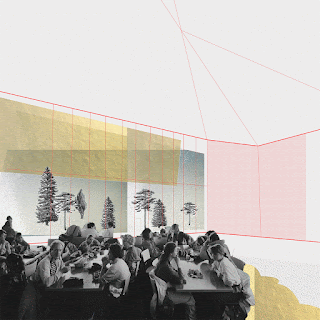Asa competition
-

Monday, July 30, 2018
Sunday, December 10, 2017
Friday, December 8, 2017
PANCHAYA SONKOM 1.3
PANCHAYA SONKOM
PROJECT 1.3
THOMAS LOZADA
FRATERNAL TWINS
Reinterpretations & Variants
This phase explores the possibilities of a 'fraternal twin' building- using the original case study's identities and any previously identified vocabularies. A series of massing models with different levels of 'zygosity' were made in the development of the new building.
The few vocabularies identified from Herman Hertzberger's Delft Montessori School includes- collaboration, individual, space modification, threshold, connectivity, split- levels, and hierarchy. Keeping these qualities in mind the following massing models were made. The first one (high zygosity) is composed of modular shapes, similar to the original building, while the rest starts varying, to include hallways of different sizes as well as skylight boxes.
(massing models photographs will be inserted later)
The final building is comprised of triangles (plan view), whose form is derived from the modular L-shaped classrooms in Hertzberger's original school building. The building consists of four classrooms, each separated by a threshold to form three different space hierarchy- individual work space, transition space, and collective space. The corridor variates in size, resulting in two large open central spaces. The new building is located a few meters from the original building, with trees lining it on both sides.
This phase explores the possibilities of a 'fraternal twin' building- using the original case study's identities and any previously identified vocabularies. A series of massing models with different levels of 'zygosity' were made in the development of the new building.
The few vocabularies identified from Herman Hertzberger's Delft Montessori School includes- collaboration, individual, space modification, threshold, connectivity, split- levels, and hierarchy. Keeping these qualities in mind the following massing models were made. The first one (high zygosity) is composed of modular shapes, similar to the original building, while the rest starts varying, to include hallways of different sizes as well as skylight boxes.
(massing models photographs will be inserted later)
The final building is comprised of triangles (plan view), whose form is derived from the modular L-shaped classrooms in Hertzberger's original school building. The building consists of four classrooms, each separated by a threshold to form three different space hierarchy- individual work space, transition space, and collective space. The corridor variates in size, resulting in two large open central spaces. The new building is located a few meters from the original building, with trees lining it on both sides.
Monday, December 4, 2017
Design 3 Phase 3 : Fraternal Twins
Massing
Since Jan Duiker is an architect that focus on function rather than aesthetics, I started building all the massing from one unit which is a cube.
High Zygosity
Apply the way Jan Duiker arranged the classrooms
Medium Zygosity
Explore different forms by arranging and stacking the cube in many different ways
Low Zygosity
Combined the 4 Medium zygosities one together in that way it can create courtyard that represents the surrounding environment of the original
All the columns were placed in the way that the beams rotated 45 degrees from the wall
DNA Building
The purpose of having the original building inside a square housing perimeter is to hide itself from other building so its modern look wouldn't clash too much with the environment at that time.
Today all the most of the buildings were replaced with new ones and the modern look is not an issue anymore, so the new building is locating in Beatrix park, The park in Amsterdam Zuid not far from the original site.
Developing from the low zygosity massing, The new building consists of five stories with one rectangular illogical placed gym. Taking the original ideas like raising the ground floor and arranging the classrooms in a certain position. One open-air classroom could be shared by two regular classrooms.
The structure also still stick to the concept of 45 degrees. The columns were arranged the same way every floor except in the corner, which slimmer tips beams were placed with no columns support.
Bour, Wirunchana Rawkwansatith : project1.3 Fraternal twins
PROJECT 1 PHASE 3
Bour Wirunchana Rawkwansatith
5934799725
Fraternal Twins
Case study: Suresnes Open Air School
My case study building was design for improve public health and to heal children who be tuberculosis name Suresnes Open Air School. So, the school was surrounded by nature and the sliding door of classroom pavilion can open. So wind can come through into the room and student can get fresh air. In the period, it have new disease from mosquito called Zika in Bolivia area. In this country, space is dense by construction and no green around.
At first, the height of old building is short but stretch in horizontal way. Moreover, I design the school in vertical and include nature in the building because this city is very dense and there is no green enough for heal the disease.
This building separate into two areas there are indoor and outdoor. At first floor is the area for facilities such as library, computer lab, storage, and stationary shop. In front of this floor is garden glass room that the tree can spread to the next floor. Second floor is a big canteen, so it can hold all students when they have lunch together in the same time. Student can go out to exterior and play in the garden outside or swim in the glass pool that parents at the first floor can see them.
The last eight floors are classroom that can open to be exterior. So student can come out to play or study out door.
Sunday, December 3, 2017
Sung Pisitt Sae-Tan Project 1.3 Arjan Peter Fisher
Project 1.3
Fraternal Twins
This project is to design the Fraternal Twins of the original building, "School of the Arts" by WOHA, Singapore. In order to design the twin, the elements in design of the building is needed to extract and use as part of the design.
The Original School analysis is as follow;
Twin Design
THE FOREST PASS
The forest Pass is designed to use the same concept of the original building but built on the different site. In the site analysis, the another location was chosen in the Marina Blvd, the site gain the advantage of being central of the public transportation and natural factor.
The main program of the site is the 'Collaborative Space' where the space is containing others program in the space. The Space is divided in 3 sections, low, mid and high. The programs in the lower area are, canteen and restaurants, exhibition and informal performing space, gallery and public workshop, sport, studio building, theater and terrace, workshop. In mid zone is the roof park that divide the public and private zone. On the higher zone is the secure space for the studio buildings and other school private facilities. However on the higher zone only the library is public space that located between two towers.
Link to full resolutionhttps://drive.google.com/open?id=14yA9NDyBfLmdwlxxs0i_AjsozH7xw5XC
Plan
Exterior view
Interior
Section
Presentation
Subscribe to:
Posts (Atom)




























































